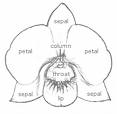The Anatomy Of An Orchid
This is a brief description on Orchid plant anatomy.
Hopefully it will be helpful if you are new to growing orchids. The roots and stem form the bottom portion of an orchid plant much the same as many flowering plants. The roots absorb and water and nutrients from the media or the surroundings and uptake them into the plant.

Sometimes with many orchids within the root system you may find the water absorption system of the orchid. These are called pseudobulbs. They are very efficient at absorbing and storing water. However, not all orchids have pseudobulbs. Remember in the rain forests where some of the orchids grow the showers are often short. So the plants have evolved water storage devices.
Above the roots you will generally find a stem from which the leaves are born. The stems are quite sturdy in some orchids and are delicate in others, especially, the miniature orchids.
A healthy leaf is one that is firm, non-wrinkled, and bright green. It is not a dark green leave which usually means that the plant needs more light.
The spike is usually the bearer of the buds and eventually the flowers. Some spikes will produce one flower or cluster of flowers (e.g. Cattleya). The Phalaenopsis spike will produce beautiful sprays of flowers all along the spike in succession.
The most intricate parts of the orchid is the flower and the structure is unique among plants with flowers. There is quite a bit of variability in orchid flowers, not only in color but also in shape. They all have fairly similar parts but they vary as to position and the number on the orchid plant.

There are usually three sepals and they are the remnants of the orchid bud. Typically there are three sepals but some orchids may only have two. The sepals are usually dorsal(back/top of the orchid) and two lateral ones.
The petals are always three in number. It is the bottom petal that is also called the "lip" or "labellum". This petal is larger and often can be quite flamboyant. It is here that forms a platform for the insects that pollinate orchids. It is also here where the most stunning orchid colors are. The orchid uses these colors as well as designs to attract the pollinators. The Paphiopedilums or lady slippers have a deeper lip that almost resembles a sack or a lady's slipper.
Please be aware that this is just the most basic of descriptions of orchid anatomy. Since there are many kinds of orchids and there is a great deal of variation in the anatomy of specific genera and species.
It is all part of what makes orchids so interesting and learning about orchids such a fascinating journey!


